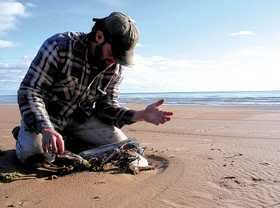Tuesday, January 29, 2008
 CHICAGO — The bird die-off was obvious as soon as Gary Rentrop and his English Setter “Birch” turned onto the Lake Michigan shore. The sugar-white sand, long buried in the crushed gray shells of invasive mussels and mats of rotting algae was now, suddenly, littered with dead birds.
CHICAGO — The bird die-off was obvious as soon as Gary Rentrop and his English Setter “Birch” turned onto the Lake Michigan shore. The sugar-white sand, long buried in the crushed gray shells of invasive mussels and mats of rotting algae was now, suddenly, littered with dead birds.
“It was almost like a war zone of birds,” said Rentrop, a Michigan lawyer who recalled his November stroll along a Michigan beach. Rentrop counted 80 carcasses on a remote mile of beach near Cross Village, just a fraction of the estimated thousands of dead mergansers, gulls, loons and other birds whose migration last autumn ended in deadly poisoning from Type E botulism on Lake Michigan.
The mounting toll on migrating birds has stoked fears among researchers and ecologists that blame for the deaths lies with invasive populations of zebra mussels and round gobies spreading over the Great Lakes, effectively creating a new food chain.
Zebra mussels and their deepwater kin, quagga mussels, filter naturally-occurring botulism and other toxins from the water. Gobies eat the mussels, and birds, in turn, eat the gobies.
Scientists theorize that this new food chain is concentrating botulism and other bottom toxins and passing them up to predators. The theory is the subject of a handful of scientific papers and upcoming research proposals.
Whatever the mechanism of transmitting the botulism, scientists in 1999 counted 311 birds in Lake Erie that appeared to die from it. The next year they counted 8,000, and it has remained in the thousands in the Great Lakes every year since. And instead of fading quickly as sporadic outbreaks did in decades past, the toxin has spread — first through Lakes Erie and Ontario, then Huron. In 2006, Lake Michigan was the most recent lake to be affected and by last autumn was one of the hardest hit.
In spreadsheets, scientists have noted the fatal effects of the annual outbreaks on more than 50 species of birds throughout the Great Lakes, from bald eagles to lowly pigeons. The list names 16 species of ducks, four types of grebes and six types of gulls. It includes double-breasted cormorants and four of Lake Michigan’s tiny piping plovers, a bird so threatened its nests get protection from police tape and fences at Sleeping Bear Dunes National Lakeshore.
The deaths of many hundreds of loons have focused new urgency on the now-annual die-offs. Loons live in small numbers, are slow to reproduce and are a symbol of northern wilderness.
The die-off that ended in November claimed an estimated 3,500 to 8,500 birds — including the loons and plovers — over hundreds of miles of beach in seven northern Michigan counties. It had spread from an estimated 2,900 birds in 2006 along just 14 miles of shoreline at Sleeping Bear Dunes, said dunes wildlife biologist Ken Hyde.
The die-off also sparked preparations for a sprawling and macabre bird count in 2008 that will involve volunteers combing hundreds of miles of Lake Michigan beaches over the summer and fall — to add up, bury and haul off what are expected to be thousands more poisoned birds and fish.“We wish we weren’t dealing with this,” said Mark Breederland, who as extension educator for the Michigan Sea Grant is organizing the upcoming response. “We’ve got enough challenges on Lake Michigan, but it’s here. It’s upon us.”
The heightened threat to Lake Michigan became clear over the summer, when shore birds began dying, possibly from picking maggots off infected fish carcasses that washed ashore.
Then came autumn. “We were getting so many loons,” said Thomas Cooley, a Michigan Department of Natural Resources biologist who performed necropsies on the birds. It takes 10 or 12 of the big birds to cover a laboratory table, he explained. “When you have two or three tables covered with those, it’s pretty sobering to look at that.”
Among the birds found dead was one of the most-studied loons in Michigan, a venerable male with four boldly colored tags on his legs and a name: “C-3.” Each year since 1993, C-3 had been observed at a pond in the Seney National Wildlife Refuge, said Damon McCormick, a wildlife biologist who studied the bird.
Adult loons return to their northern nesting grounds by early spring about 93 percent of the time, McCormick said. This year, researchers will be watching for them anxiously. A decline in adult population would almost certainly spell a decline among loons.
Source
Silahkan Beri Komentar Anda Mengenai Berita/Artikel Ini.
Labels: English News

0 comments:
Post a Comment